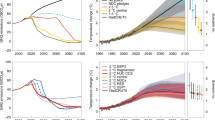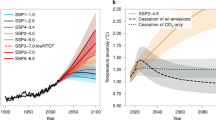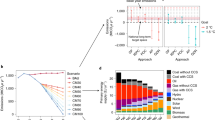Abstract
In recent years, international climate policy has increasingly focused on limiting temperature rise, as opposed to achieving greenhouse-gas-concentration-related objectives. The agreements reached at the United Nations Framework Convention on Climate Change conference in Cancun in 2010 recognize that countries should take urgent action to limit the increase in global average temperature to less than 2 °C relative to pre-industrial levels1. If this is to be achieved, policymakers need robust information about the amounts of future greenhouse-gas emissions that are consistent with such temperature limits. This, in turn, requires an understanding of both the technical and economic implications of reducing emissions and the processes that link emissions to temperature. Here we consider both of these aspects by reanalysing a large set of published emission scenarios from integrated assessment models in a risk-based climate modelling framework. We find that in the set of scenarios with a ‘likely’ (greater than 66%) chance of staying below 2 °C, emissions peak between 2010 and 2020 and fall to a median level of 44 Gt of CO2 equivalent in 2020 (compared with estimated median emissions across the scenario set of 48 Gt of CO2 equivalent in 2010). Our analysis confirms that if the mechanisms needed to enable an early peak in global emissions followed by steep reductions are not put in place, there is a significant risk that the 2 °C target will not be achieved.
This is a preview of subscription content, access via your institution
Access options
Subscribe to this journal
Receive 12 print issues and online access
$209.00 per year
only $17.42 per issue
Buy this article
- Purchase on Springer Link
- Instant access to full article PDF
Prices may be subject to local taxes which are calculated during checkout

Similar content being viewed by others
References
United Nations Framework Convention on Climate Change Report of the Conference of the Parties on its Sixteenth Session, held in Cancun from 29 November to 10 December 2010 (FCCC/CP/2010/7/Add.1, United Nations, 2011); available at http://unfcc.int/resource/docs/2010/cop16/eng/07a01.pdf.
Meinshausen, M. et al. Greenhouse-gas emission targets for limiting global warming to 2 °C. Nature 458, 1158–1162 (2009).
Matthews, H. D., Gillett, N. P., Stott, P. A. & Zickfeld, K. The proportionality of global warming to cumulative carbon emissions. Nature 459, 829–832 (2009).
Allen, M. R. et al. Warming caused by cumulative carbon emissions towards the trillionth tonne. Nature 458, 1163–1166 (2009).
Archer, D. et al. Atmospheric lifetime of fossil fuel carbon dioxide. Annu. Rev. Earth Planet. Sci. 37, 117–134 (2009).
Plattner, G. K. et al. Long-term climate commitments projected with climate & carbon cycle models. J. Clim. 21, 2721–2751 (2008).
Lowe, J. A. et al. How difficult is it to recover from dangerous levels of global warming? Environ. Res. Lett. 4, 014012 (2009).
United Nations Environment Programme The Emissions Gap Report — Are the Copenhagen Accord Pledges Sufficient to Limit Global Warming to 2 ° C or 1.5 °C? (UNEP, 2010).
Held, I. M. et al. Probing the fast and slow components of global warming by returning abruptly to preindustrial forcing. J. Clim. 23, 2418–2427 (2010).
Solomon, S. et al. Persistence of climate changes due to a range of greenhouse gases. Proc. Natl Acad. Sci. USA 107, 18354–18359 (2010).
Schewe, J., Levermann, A. & Meinshausen, M. Climate change under a scenario near 1.5 °C of global warming: Monsoon intensification, ocean warming and steric sea level rise. Earth Syst. Dynam. 2, 25–35 (2011).
Clarke, L. et al. International climate policy architectures: Overview of the EMF 22 International Scenarios. Energy Econ. 31, S64–S81 (2009).
Edenhofer, O. et al. The economics of low stabilization: Model comparison of mitigation strategies and costs. Energy J. 31, 11–48 (2010).
van Vuuren, D. & Riahi, K. The relationship between short-term emissions and long-term concentration targets. Climatic Change 104, 793–801 (2011).
IPCC Climate Change 2007: Mitigation of Climate Change (eds Metz, B., Davidson, O. R., Bosch, P. R., Dave, R., & Meyer, L. A.) (Cambridge Univ. Press, 2007).
Meinshausen, M., Raper, S. C. B. & Wigley, T. M. L. Emulating coupled atmosphere-ocean and carbon cycle models with a simpler model, MAGICC6 — Part 1: Model description and calibration. Atmos. Chem. Phys. 11, 1417–1456 (2011).
van Vuuren, D. et al. How well do integrated assessment models simulate climate change? Climatic Change 104, 255–285 (2011).
IPCC Special Report on Carbon Dioxide Capture and Storage (eds Metz, B., Davidson, O., de Coninck, H., Loos, M. & Meyer, L.) (Cambridge Univ. Press, 2005).
Azar, C. et al. The feasibility of low CO2 concentration targets and the role of bio-energy with carbon capture and storage (BECCS). Climatic Change 100, 195–202 (2010).
Barker, T. & Scrieciu, S. Modeling low climate stabilization with E3MG: Towards a ‘new economics’ approach to simulating energy–environment–economy system dynamics. Energy J. 31, 137–164 (2010).
Loulou, R., Labriet, M. & Kanudia, A. Deterministic and stochastic analysis of alternative climate targets under differentiated cooperation regimes. Energy Econ. 31, S131–S143 (2009).
Krey, V. & Riahi, K. Implications of delayed participation and technology failure for the feasibility, costs, and likelihood of staying below temperature targets—Greenhouse gas mitigation scenarios for the 21st century. Energy Econ. 31, S94–S106 (2009).
Calvin, K. et al. 2.6: Limiting climate change to 450 ppm CO2 equivalent in the 21st century. Energy Econ. 31, S107–S120 (2009).
Wise, M. A. et al. Implications of limiting CO2 concentrations for land use and energy. Science 324, 1183–1186 (2009).
O’Neill, B. C., Riahi, K. & Keppo, I. Mitigation implications of midcentury targets that preserve long-term climate policy options. Proc. Natl Acad. Sci. USA 107, 1011–1016 (2009).
Tebaldi, C. & Knutti, R. The use of the multi-model ensemble in probabilistic climate projections. Phil. Trans. R. Soc. A 365, 2053–2075 (2007).
Luderer, G. et al. The economics of decarbonizing the energy system—results and insights from the RECIPE model intercomparison. Climatic Changehttp://dx.doi.org/10.1007/s10584-011-0105-x (2011).
Rogelj, J., Hare, W., Chen, C. & Meinshausen, M. Discrepancies in historical emissions point to a wider 2020 gap between 2 °C benchmarks and aggregated national mitigation pledges. Environ. Res. Lett. 6, 1–9 (2011).
Meinshausen, M. et al. The RCP greenhouse gas concentrations and their extensions from 1765 to 2300. Climatic Changehttp://dx.doi.org/10.1007/s10584-011-0156-z (2011).
Granier, C. et al. Evolution of anthropogenic and biomass burning emissions of air pollutants at global and regional scales during the 1980–2010 period. Climatic Changehttp://dx.doi.org/10.1007/s10584-011-0154-1 (2011).
van Vuuren, D. et al. RCP2.6: Exploring the possibility to keep global mean temperature increase below 2 °C. Climatic Changehttp://dx.doi.org/10.1007/s10584-011-0152-3 (2011).
Meinshausen, M., Wigley, T. M. L. & Raper, S. C. B. Emulating atmosphere–ocean and carbon cycle models with a simpler model, MAGICC6 — Part 2: Applications. Atmos. Chem. Phys. 11, 1457–1471 (2011).
IPCC Climate Change 2007: The Physical Science Basis (eds Solomon, S. et al.) (Cambridge Univ. Press, 2007).
Friedlingstein, P. et al. Climate–carbon cycle feedback analysis: Results from the C4MIP model intercomparison. J. Clim. 19, 3337–3353 (2006).
Acknowledgements
The authors gratefully thank everyone involved in the UNEP Emissions Gap Report, and acknowledge the contributions of all modelling groups that provided data and information, all co-authors from the UNEP Emissions Gap Report and others who provided comments, in particular B. Knopf, G. Luderer, E. Sawin, B. O’Neill, B. Ward, N. Ranger, V. Bossetti and R. Knutti. J.R. was supported by the Swiss National Science Foundation (project 200021-135067). J.L. was supported by the Joint DECC/Defra Met Office Hadley Centre Climate Programme (GA01101) and the AVOID programme (GA0215).
Author information
Authors and Affiliations
Contributions
J.R., W.H., J.L., K.R., B.M., M.M. and D.P.v.V. designed the research. M.M. developed the climate model set-up. J.R. carried out the research. All authors discussed the results and contributed to writing the paper.
Corresponding author
Ethics declarations
Competing interests
The authors declare no competing financial interests.
Supplementary information
Rights and permissions
About this article
Cite this article
Rogelj, J., Hare, W., Lowe, J. et al. Emission pathways consistent with a 2 °C global temperature limit. Nature Clim Change 1, 413–418 (2011). https://doi.org/10.1038/nclimate1258
Received:
Accepted:
Published:
Issue Date:
DOI: https://doi.org/10.1038/nclimate1258
This article is cited by
-
Emissions savings from equitable energy demand reduction
Nature Energy (2023)
-
Mapping the field of bioenergy with carbon capture and storage (BECCS): scientific cooperation and co-citation analyses
Environmental Science and Pollution Research (2023)
-
Carbon sequestration and \(\hbox {CO}_{2}\) CO 2 absorption by agroforestry systems: An assessment for Central Plateau and Hill region of India
Journal of Earth System Science (2019)
-
Not all carbon dioxide emission scenarios are equally likely: a subjective expert assessment
Climatic Change (2019)
-
Contribution of forest wood products to negative emissions: historical comparative analysis from 1960 to 2015 in Norway, Sweden and Finland
Carbon Balance and Management (2018)



